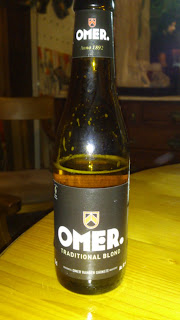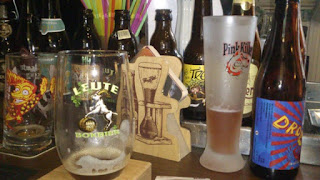 We’ve been on holiday –
we visited Bruges, Brussels and very briefly Ghent in Belgium. It was a whirlwind – we have returned tired
and ill, but it was worth it. Now I
thought I’d have recipes and foodie pics to share, however after the first 2
nights of traditional home cooked Flemish stew, followed by sausages, mash and
red cabbage the dining veered off to the chip shop variety and we
gorged – yes gorged – on Bicky Burgers, (www.bicky.be) frites and all things deep
fried. “All things” meaning I have no
idea what the rest of it was – they told me it was a variety of meats – it all kinda
looked the same really. Honestly, apart
from the Bicky burgers it wasn’t all great – think kebab when sober….
We’ve been on holiday –
we visited Bruges, Brussels and very briefly Ghent in Belgium. It was a whirlwind – we have returned tired
and ill, but it was worth it. Now I
thought I’d have recipes and foodie pics to share, however after the first 2
nights of traditional home cooked Flemish stew, followed by sausages, mash and
red cabbage the dining veered off to the chip shop variety and we
gorged – yes gorged – on Bicky Burgers, (www.bicky.be) frites and all things deep
fried. “All things” meaning I have no
idea what the rest of it was – they told me it was a variety of meats – it all kinda
looked the same really. Honestly, apart
from the Bicky burgers it wasn’t all great – think kebab when sober….
However where my culinary
experiences failed, my beer drinking flourished! So I am happy to share my pics of the beers I
found, drank and enjoyed. Even though I
only sampled a small selection, I thought I’d give you some more info on the great
Belgium Beers anyway – if interested you can do your own digging or make your
own visits too!
(The following info has
been read and verified by a true Belgian by the way!)
FACTS:
- Belgium currently has approximately 250 breweries
- The Average Belgian drinks 84 litres of beer per year
- Most of the stronger Belgian beers are served from a bottle (not a can) as they actually ferment for longer in the bottle itself, the storage is part of the proces
- Plus the majority have their own unique style of glass/drinking vessel too – if a bar has run out, good bar staff would probably be embarrassed to serve beers from a bottle in the incorrect glass!
TRAPPIST MONASTERY BEERS:
- French and Flemish Abbeys first started brewing beers as a way to raise funds – since the 1100’s when this started, brewing methods have evolved but only under abbey supervision!
- Trappist monasteries (the order originating in the Cistercian monastery, La Trappe – France) brew traditional beers/ales in Belgium.
- To qualify for Trappist certification the brewery must be in a monastery, monks must be involved in the beer production and the profits from beer sales must go back to support the monastery
- There are currently 10 monasteries meeting these standards – 6 of which are in Belgium
- The current Belgian Trappist producers are:
ACHEL
CHIMAY
ORVAL
ROCHEFORT
WESTMALLE
WESTVLETEREN
ABBEY BEERS:
- There are of course many beer products made now in the same style – they are produced however in non Trappist monasteries or in commercial breweries under agreement
- Although Abbey beers do not confirm to the rigid brewing style, they do include the most distinctive Trappist brown ales (Dubbel), strong pale ales (Trpel) and blonde ales (Blonde)
BELGIAN BEER TYPES:
If you want to find out
more, as far as I can distinguish from chats and internet searching – there are
a number of Belgian Beer Types – this may be the easiest way to distinguish and
find out more about the ones you like:
Blonde (golden) Ales – eg: DUVEL (www.duvel.com) is one of Belgium’s most popular blondes
Brown Ale/Dubbel – classic Trappist or Abbey style. Strong beers, typically between 6-8%
Lambic (fruit wheat beers) – the most common being KRIEK (www.wikipedia.org/wiki/Kriek_lambic) made with sour cherries
Flemish Red – a sour style ale originally from West Flanders. My favourite and best example being BUCCHAS
Pils / pale lager – The bulk of beer production and consumption in Belgium, top brand being JUPILER (www.jupiler.be *you may want to use google translate for this page) or Stella Artois as distributed globally
Tripel (strong pale ale) First associated with WESTMALLE (www.trappistwestmalle.be/en/page/home.aspx) and now widely copied across Belgium and other countries
White (wheat beer) originated in the Flemish part of Belgium with HOEGAARDEN (www.hoegaarden.com) being the most famous wheat beer producing town
GLASSES AND DRINKING:
- Bottled beers are often served in elaborate glassware
- More often than not, bars have specific glasses and each beer will be served in its own glass
- This is to A) trap aromas B) maintain the correct head and C) create a visual sensation too!
So from the beers I
sampled I’d like to recommend the following:
In 3rd place - Delirium – (blonde/golden ale) voted
one of the best beers in the world for the last 3 years. The delirium café in Brussels actually stocks
over 2000 Belgian beers on its menu – 2000!
Runner up in 2nd
- La Chouffe – (pale ale) with a
hint of coriander (apparently!) Can’t
say I could taste that, but there was a certain something that made it stand
out from any other paler beers I sampled
And my very favourite –
my winner of all beers = BACCHUS –
(old Flemish brown ale) with a fruity sour accent – in a good way! It’s from West Flanders and with relatively
“low” alcohol content at just 4.5%.
I’d also like to give a
shout out to YESTERDAYS WORLD The
BEST bar we found in Bruges, with the advantage that it’s like walking into a
treasure chest. My only recommendation is GO THERE and SEE FOR YOURSELF. Wonderful beers, atmosphere, hospitality and decoration.
Finally as a word of warning
– obviously you can only visit the websites listed and taste these beers if you
are of legal drinking age PLUS please beware Belgian beers are typically much
stronger than a pint down the local British pub. We may be used to a full pint of 3.5-5% lager,
but 7-8% is common and 10-11% beers are not rare in the Belgian bars.
For more info please visit www.nitakothari.com You can email us on info@nitakothari.com and see our Facebook page. You can
also follow and tweet us here: Twitter
and see the beer images and more on Instagram
**Please remember this is nutritional
advice ONLY (as is all other information and advice contained in this blog and
the websites and social media related to it) – none of the info or advice is
intended to override any recommendation from your GP or health professional**
**In this case, please drink responsibly and of course be aware alcohol is to be consumed by and the related beer websites are to be visited by those of the legal drinking age only**







No comments:
Post a Comment